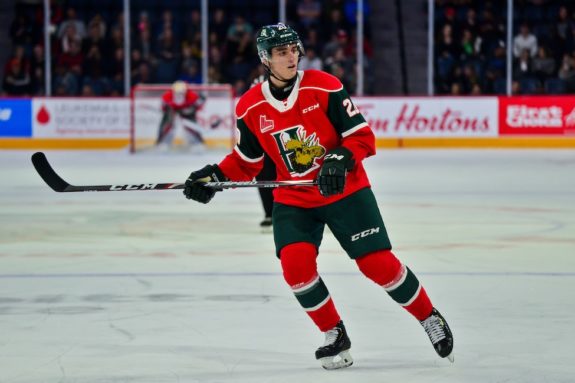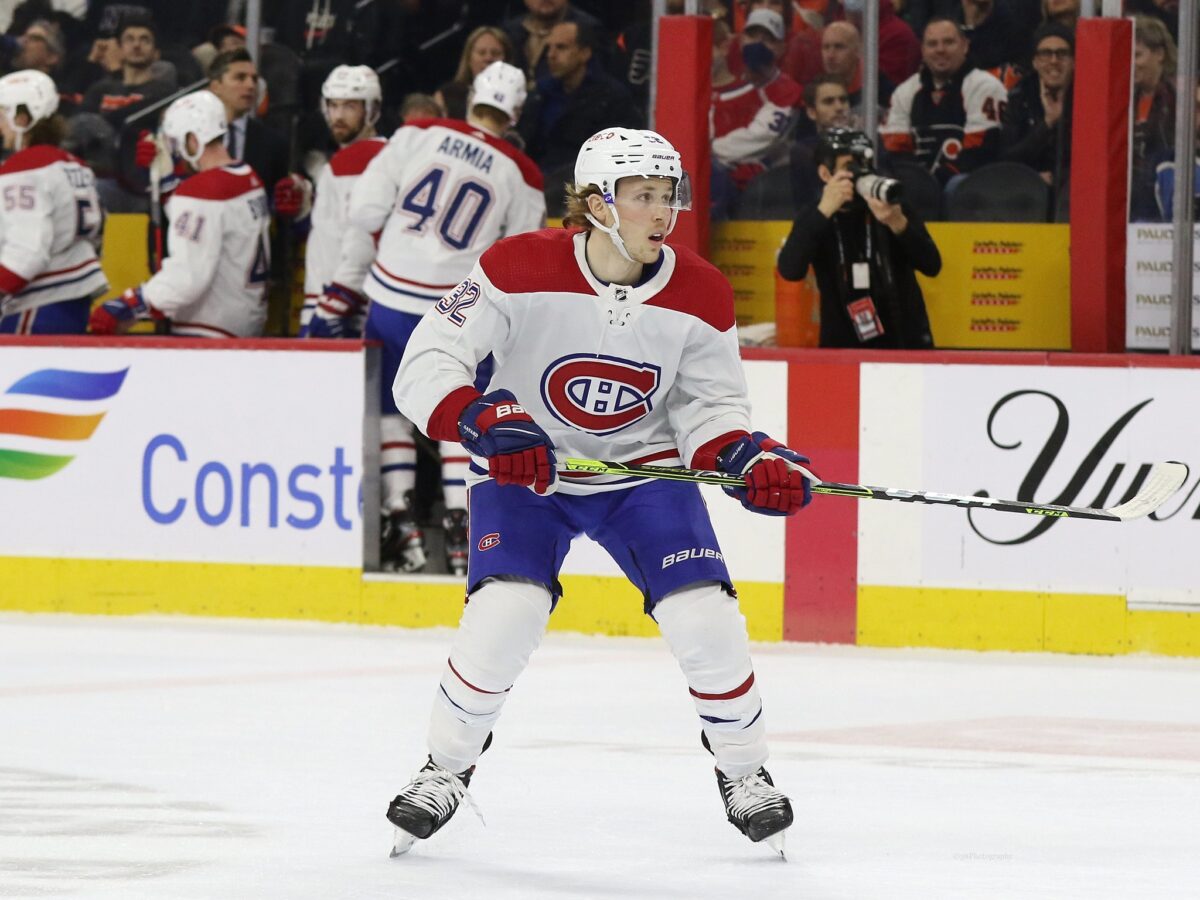It has been a roller-coaster of a year for Montreal Canadiens fans. They witnessed a Stanley Cup Final appearance followed by a historic collapse leaving the franchise with its worst winning percentage in team history after 40 games. This was followed by a complete upheaval in the front office as team owner Geoff Molson chose to hire Jeff Gorton as executive vice president to head up his hockey operations department. Then, the hiring of former player agent Kent Hughes as the new general manager (GM).
Since that time, Martin St. Louis was hired as the interim head coach, and almost overnight, turned a team that was an also-ran into a persistent group of players, and won over fans by demanding a fast-paced, entertaining brand of hockey.
Now that the NHL trade deadline has passed, we can look at the prospect pool again to see how a season of development and the addition of new prospects could change the outlook of this franchise’s future.
Definition of a Prospect
For this exercise, I will keep the definition of a prospect simple. It is a player who is in their rookie NHL season or playing in a lower league, professional or amateur, and has not played a season in the NHL previously. For goaltenders, they must not have played 50 NHL games. Also, they must be 25 years of age or younger
Related: Canadiens Prospect Pyramid
Using this as the basis to follow, names such as Nick Suzuki and Alexander Romanov no longer apply. Adding them to this pyramid would greatly improve the outlook of the prospect pool for the team, despite all of them being 22 years old, they are already impactful NHL players for the franchise and do not meet the standards set in the definition.
Pyramid Tiers
A pyramid is just as subjective as any other traditionally used ranking system. What this approach will do is look at a prospect’s potential as opposed to arguing why Prospect A is ranked fourth over Prospect B.
The Tiers are as follows:
Tier 1 – Elite or top-line, top-pair talent
Tier 2 – Top-six forward, top-four defender, starting goaltender
Tier 3 – Third-line forward, bottom-pair defender, backup goaltender
Tier 4 – Role players, bottom-line forward, depth defenceman or forward
Tier 5 – Minor league player used for call-ups
Tier 1
Elite or Top-Line, Top-Pair Talent
Cole Caufield remains the only player in this tier. Despite an epically disappointing start to his rookie season, a season he was expected to compete for the Calder Trophy as the NHL’s top rookie, he remains the Habs’ top “prospect”. With his game-breaking ability, it is difficult to take him out of this tier – especially now since St. Louis has re-launched his season. In his first 30 games under Dominique Ducharme, he scored one goal and eight points. In the 21 games since St. Louis’ arrival behind the bench, he has scored 13 goals and 25 points. This has been directly tied to Caufield rediscovering his confidence, which can likely be from having his coach place him on a top line with Suzuki and Josh Anderson, as well as having his shot finally being used as a power-play weapon.
Tier 2
Top-6 Forward, Top-4 Defender, Starting Goaltender
This tier has some new faces thanks to trades and some leaps in player development. The new face is Justin Barron, a right-shot puck-moving defenceman who was acquired from the Colorado Avalanche in the Artturi Lehkonen trade. The 20-year-old is expected to have a significant impact on the roster very soon.

Two players who have moved up into this tier thanks to their development over the season are Sean Farrell and Joshua Roy. Farrell moves up in large part due to his offensive play at Harvard University being a catalyst for the Crimson in winning their conference championship. He was also the team leader in points for Team USA at the 2022 Olympic Games. Roy moves up due to his hard work in the offseason, focusing on his off-ice preparations which led to him becoming the Quebec Major Junior Hockey League (QMJHL) leader in points as well as the final cut from the postponed 2022 World Junior Championships.
The final new arrival to this tier is goaltender Frederik Dichow. After signing last season to play with the Ontario Hockey League’s (OHL) Sudbury Wolves, the pandemic canceled the 2020-21 season. Soon after, he chose to return to Europe, signing with Kristianstads of the Swedish Hockey League. This season saw him start 28 games, earning an 18-9 record with a 2.27 goals-against average (GAA) and an impressive .930 save percentage (SV%). He also started one game for Team Denmark at the 2022 Olympics where he earned a .969 SV%, allowing one goal in a 2-0 loss to a much more skilled Russian team.
The other members of this tier remain the same. They are, Jesse Ylonen, Kaiden Guhle, Cayden Primeau, Jayden Struble, newly-signed Jordan Harris, Luke Tuch, Logan Mailloux, Matthias Norlinder, and Jan Mysac.
Tier 3
Third-Line Forward, Bottom-Pair Defender, Backup Goaltender
This tier comprises the majority of the Canadiens’ prospect pool. That is not something to be upset about as every team depends on players at this level to fill out their rosters. They provide quality and predictable play on team-friendly contracts which allows a GM to spend money on top players while building a winning team.
Arber Xhekaj steps into this tier. He was added to the Canadiens as an undrafted prospect this past fall after an impressive main training camp where he showed mobility and physicality. So far this season in the OHL, the 6-foot-4, 225-pound defenceman has 11 goals and 33 points to go with his 123 penalty minutes. He will play an integral role for the Hamilton Bulldogs in their playoff hopes this spring.
Rem Pitlick was a waiver wire addition from the Minnesota Wild, since then, however, he has been a revelation, playing center and wing, scoring seven goals and 19 points in his 30 games with Montreal and climbing into the top-10 in rookie scoring.

Josh Brook, Lukas Vejdemo, Riley Kidney, Raphael Harvey-Pinard, Oliver Kapanen, Jakub Dobes, Emil Heineman, Daniil Sobolev, and Ty Smilanic round out the group in this tier.
Tier 4
Role Players, Bottom-Line Forward, Depth Defenceman or Forward
At best, the hope is for some of these players to make it into the NHL and provide some depth in case of injuries, or, develop their skills to move up the pyramid if at all possible.
This tier includes Cam Hillis, Dmitri Kostenko, Blake Biond, Rhett Pitlick, William Trudeau, Joe Vrbetic, Joel Teasdale, Micheal Pezzetta, Gianni Faibrother and Alexander Gordin.
Tier 5
Minor-League Players Used for Call-Ups
At the very least, these players will provide the Laval Rocket quality play to help them in their Calder Cup playoff bids.
Some players in this tier have some skills that could help them move up the pyramid. Namely, Brett Stapely. As a senior at the University of Denver, he has become one of the offensive leaders of his program. In 2022, he helped his team to the NCAA Frozen Four.
Arvid Henrikson is unlikely to get a contract offer this summer, making him an unrestricted free agent. Jacob Oloffson is another player in need of a contract this summer. However, after two injury-plagued seasons in which his development has stagnated, coupled with the Habs having so many prospects to choose from, he is unlikely to receive a contract offer.
The other players in this tier are Jack Gorniak, Jack Smith, and Xavier Simoneau.

Under new management, the Canadiens have chosen to shift their focus to player development. With the new director of development, Adam Nicholas hired, there will be a targeted plan to build upon skating and puck skills. With the ECHL’s Trois-Rivières Lions, and an ability to use European leagues and the NCAA to allow prospects to mature in lower levels, player development will finally become a cornerstone for any of the franchise’s future success.
The Canadiens have a deep prospect pool filled with good prospects that are expected to become productive NHL players in secondary or support roles. That pool will have several new additions in the coming drafts as the Habs hold 14 picks in the 2022 Draft and as of March 2022, they look forward to adding quality as well as they have 14 top-90 draft picks over the next three drafts.
